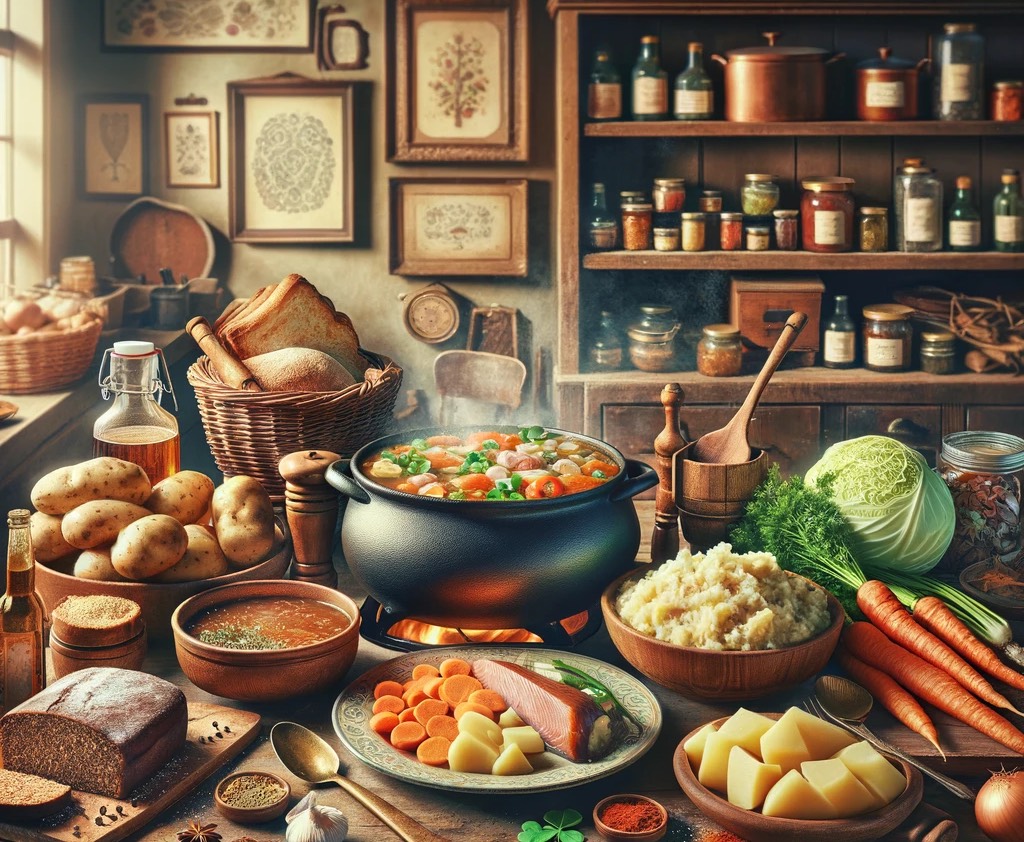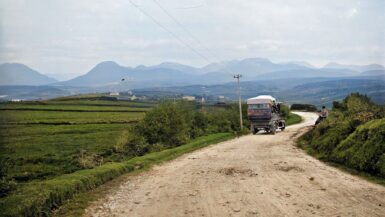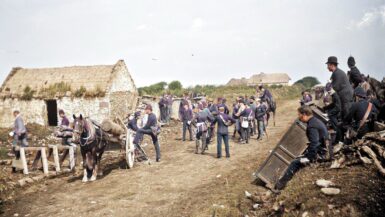Irish cuisine is characterized by its hearty, comforting nature, often featuring simple, wholesome ingredients. Stemming from a rich cultural history and a landscape abundant in agricultural resources, Irish food traditionally highlights staples like potatoes, meat (particularly beef and lamb), seafood, and a variety of dairy products. This cuisine is shaped by Ireland’s history, geography, and social changes, reflecting the adaptability and resourcefulness of its people.
Contents
The Roots of Irish Gastronomy
The evolution of Irish gastronomy is deeply intertwined with the country’s history and landscape. From the pastoral practices of early settlers to the introduction of new crops and livestock by invaders and traders, each epoch in Ireland’s history has left an indelible mark on its culinary traditions.
Historical Influences
Ireland’s culinary history begins with its ancient inhabitants, primarily pastoralists who relied heavily on dairy and meat from cattle. The Celts, who arrived around 500 BC, brought with them iron tools and advanced agriculture, enhancing crop cultivation and animal husbandry.
The arrival of the Vikings in the 8th century marked a significant change, introducing techniques like smoking and salting, particularly for fish preservation. This era expanded the Irish diet to include a wider variety of seafood, a staple along the Irish coastlines.
In the 12th century, the Norman invasion introduced new agricultural practices and ingredients. They brought advanced farming techniques, new crops like wheat and legumes, and a greater variety of spices and cooking methods. This period saw an increase in trade and a diversification of the Irish diet.
The Role of Agriculture
Agriculture has been the backbone of Irish society and its cuisine. The fertile Irish soil and favorable climate have supported farming practices for centuries. Dairy farming, in particular, has been crucial, with products like butter and cheese being central to the Irish diet. The quality of Irish dairy is attributed to the lush, nutrient-rich grass that covers much of the country.
The introduction of the potato in the late 16th century revolutionized Irish agriculture and cuisine. The potato thrived in Irish soil and became a staple, leading to dishes like Colcannon and Boxty. However, the dependence on this single crop also led to the Great Famine (1845-1849) when potato blight devastated crops, causing widespread starvation and emigration. This event profoundly affected the population and economy, reshaping the country’s agricultural practices and cuisine.
Staple Foods in Irish Diet
Ireland’s culinary landscape is shaped by its staple foods, which are deeply rooted in the country’s agricultural practices and cultural heritage. The most prominent staples in the Irish diet are potatoes, various types of bread, and dairy products.
Potatoes: The Heart of Many Dishes
Introduced to Ireland in the late 16th century, potatoes quickly became a staple food due to their nutritional value, ease of cultivation, and versatility. Potatoes are central to many traditional Irish dishes. They are used in various forms, from boiled and mashed to roasted and baked. Dishes like Colcannon, made from mashed potatoes mixed with cabbage or kale, and Boxty, a type of potato pancake, are quintessential examples of traditional potato-based Irish cuisine.
The potato’s significance extends beyond its culinary use. The Great Famine of the 1840s, caused by potato blight, had a profound impact on Ireland, leading to mass starvation and emigration. This tragedy underscored the importance of potatoes in Irish society and cuisine.
Bread and Baking
Bread is a fundamental part of the Irish diet. Soda bread, a quick bread that uses baking soda as a leavening agent instead of yeast, is a staple in Irish households. It’s traditionally made with buttermilk and may include ingredients like oats or seeds for added texture. Another popular bread is the brown bread, a wholemeal bread also known as wheaten bread, valued for its nutritious and hearty nature.
Irish bread is often enjoyed with butter, another staple of the Irish diet, or used as an accompaniment to soups and stews. The simplicity and quick preparation of these breads have made them a longstanding favorite in Irish kitchens.
Dairy Products
Ireland’s rich pastures make it an ideal place for dairy farming, and as a result, dairy products are central to the Irish diet. Irish butter, known for its high butterfat content and rich flavor, is a key ingredient in both cooking and baking. Irish cheeses, ranging from sharp Cheddars to soft Brie-style cheeses, are also widely consumed and have gained international acclaim.
Dairy products are not just used as accompaniments but are often integral to the preparation of traditional dishes, such as in the making of white sauces or in the enrichment of soups and stews.
Traditional Irish Dishes
The diversity of traditional Irish dishes reflects the country’s agricultural heritage and resourceful culinary practices.
Hearty Stews and Soups
Irish stew, originally a peasant dish, is a testament to the simplicity and nourishment of traditional Irish cuisine. Typically made with lamb or mutton, potatoes, onions, and carrots, it is slow-cooked until the meat is tender and the flavors are melded. Variations exist, with some regions adding barley or root vegetables.
Soup is also a mainstay in Irish cuisine, with recipes like vegetable soup and seafood chowder being particularly popular. These soups are often enriched with cream or butter, making them both filling and comforting.
Seafood and Fish
Ireland’s extensive coastline provides a bounty of seafood, making fish a significant part of the diet, particularly in coastal areas. Traditional dishes include smoked salmon, often served with brown bread, and seafood chowder, a creamy soup with a mix of local seafood like mussels, clams, and prawns.
Meat Dishes
Meat, particularly beef and lamb, plays a prominent role in Irish cuisine. Corned beef and cabbage, though more associated with Irish-American cuisine, has its roots in Ireland. Bacon and cabbage is a more traditional Irish dish, typically made with back bacon and served with potatoes. These dishes reflect the importance of livestock in Irish agriculture and the traditional methods of meat preservation.
Ingredients Unique to Irish Cuisine
The uniqueness of Irish cuisine is partly due to its use of local ingredients, including native herbs, vegetables, and seafood. These ingredients not only add distinctive flavors but also reflect Ireland’s rich natural heritage.
Native Herbs and Vegetables
Ireland’s climate and soil conditions are conducive to growing a variety of native herbs and vegetables that are integral to traditional dishes. Herbs like rosemary, thyme, and parsley are commonly used for flavoring stews and roasts. Unique to Ireland is dillisk (dulse), a type of edible seaweed, traditionally dried and eaten as a snack or used to flavor dishes, imparting a distinct, earthy taste.
Irish root vegetables like parsnips, turnips, and carrots are staple components in many traditional recipes, particularly in hearty stews and soups. These vegetables thrive in the Irish climate and add depth and sweetness to dishes.
Seafood and Coastal Delights
Ireland’s extensive coastline offers a rich supply of seafood, integral to its culinary identity. Beyond the well-known salmon and cod, the Irish waters are also home to a variety of shellfish, such as mussels, oysters, and clams. Dishes like the Dublin Bay prawn and Galway oysters are celebrated for their freshness and flavor. Seafood is often prepared simply, with minimal seasoning, to highlight its natural taste.
Festive and Seasonal Foods
Irish cuisine is closely tied to the seasons and various festivals, with specific dishes marking different times of the year.
Traditional Holiday Foods
During holidays, certain foods take center stage in Irish households. On St. Patrick’s Day, the traditional dish of bacon and cabbage is often served, sometimes accompanied by soda bread. Christmas in Ireland is marked by a feast, with roast turkey or goose, ham, and a range of sides like roasted vegetables and stuffing. Desserts such as Christmas pudding and mince pies are a must.
Other festive foods include barmbrack, a fruit bread served during Halloween, which traditionally contains various objects baked into the bread, used as a sort of fortune-telling game.
Seasonal Eating
In line with the agricultural calendar, Irish cuisine adapts to the seasons. Spring brings fresh dairy and lamb, summer is marked by the abundance of fresh fruits and berries, autumn welcomes the harvest of root vegetables and apples, and winter is the time for hearty stews and soups, made with preserved and stored produce.
In coastal areas, the seafood available changes with the seasons, with some fish like mackerel being more abundant in summer, while shellfish like oysters are traditionally associated with colder months.
Contemporary Irish Cuisine
In recent years, Irish cuisine has witnessed a renaissance, merging traditional flavors with modern culinary techniques and global influences.
The Modern Twist
Contemporary Irish chefs are reinterpreting traditional dishes by infusing them with innovative concepts and international flavors. This new wave of Irish cuisine focuses on local, high-quality ingredients, but presents them in a more refined and creative manner. For example, classic Irish stew is being reinvented with unexpected ingredients or presented as a deconstructed dish in fine dining establishments. Similarly, modern versions of Boxty might incorporate unconventional flavors or be served alongside gourmet components.
Farm-to-Table Movement
The farm-to-table movement has gained significant momentum in Ireland, emphasizing sustainable and local sourcing of ingredients. Irish chefs and restaurants are increasingly collaborating with local farmers, fishermen, and artisans, showcasing the best of Irish produce. This movement not only supports local economies but also ensures the freshness and quality of the ingredients, with a focus on organic and ethically produced goods.
Regional Variations
Ireland’s culinary landscape is as diverse as its regions, each area boasting its own unique specialties and traditions.
The Richness of Regional Cuisines
From the seafood-rich coasts to the meat and dairy-producing inland areas, regional variations in Irish cuisine are pronounced. Coastal areas like Galway and Cork are renowned for their seafood, while the inland regions are known for their quality meats and dairy products. The differences in regional cuisines are a reflection of the local environment, history, and cultural influences.
Local Specialties
Each region in Ireland has its unique specialties. For example, the Galway Oyster Festival celebrates the region’s famous oysters. In Cork, you might find specialties like Drisheen, a traditional type of blood pudding. The Ulster Fry, a hearty breakfast plate, is a staple in Northern Ireland. These local specialties not only add to the richness of Irish cuisine but also contribute to the cultural identity of each region.
Preserving Irish Culinary Traditions
In the midst of modernization and global influences, there is a concerted effort to preserve traditional Irish culinary practices and dishes.
Role of Food in Irish Culture
Food plays a significant role in Irish culture, serving as a medium for storytelling, community gatherings, and the preservation of history. Traditional recipes passed down through generations are a testament to Ireland’s culinary heritage. Festivals, cooking workshops, and community events often revolve around traditional Irish foods, celebrating the country’s rich culinary history and educating younger generations.
Promoting Irish Cuisine Globally
Efforts to promote Irish cuisine on a global stage have increased in recent years. This includes the participation of Irish chefs and culinary experts in international food festivals and events, as well as initiatives by the Irish government and tourism boards to market Ireland as a destination for culinary tourism. These efforts not only help in preserving Irish culinary traditions but also showcase the evolution and diversity of Irish cuisine to a global audience.






Leave a reply